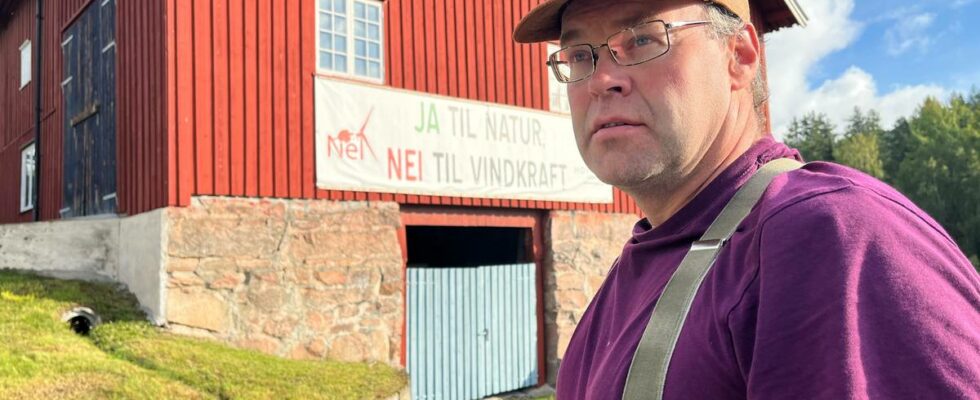The case in summary: Peace. Olsen Renewables AS plans to build a wind power plant with 57 turbines in Drangedal and Nome municipalities in Telemark, which has caused great local opposition. Local farmer, Jørgen Lensegraf Melås, expresses strong frustration with the plans and does not want Energy Minister Terje Aasland in the area. The Minister of Energy emphasizes that Norway needs more power, and that it is the municipal politicians who have the power to decide on the development. Former state secretary in the Ministry of Energy, Amund Vik, believes that the introduction of a municipal wind power veto has created discord in many local communities. The summary is made by an AI service from OpenAi. The content is quality assured by news’s journalists before publication. – He should really stay away from the village. This is not something we want to have here. Aasland can stay in Oslo, so he can work to fix our power industry in Norway. That’s what an irritated farmer and resident of Drangedal, Jørgen Lensegraf Melås, says. Peace. Olsen Renewables AS has plans to build 57 wind turbines at Lundeheia. The planned area is 32 square kilometers, as large as half the municipality of Horten. On Friday, Energy Minister Terje Aasland came to Drangedal to be briefed on the plans. Energy Minister Terje Aasland came to Drangedal on Friday. Not everyone liked that. Photo: Lars Tore Endresen / news – I have to accept, but not respect, that I am not welcome. I am in the village and want to look at the project and talk to those who are interested in it. I also talk to the opponents, and listen to them, says Aasland. He speaks clearly to those who believe that Norway does not need more power. – They are completely wrong. If they want industry and business to be shut down and flagged out of Norway, then we can only stop development. Has no power The turbines will produce around 0.8 to 1.2 terawatt-hours. 1 terawatt-hour corresponds to the total electricity consumption in a city the size of Drammen during one year. The turbines can be up to 250 meters high, and can be ready in 2030. This is what it could look like if there is a wind power plant in the area. Photo: Fred Olsen Renemables – I don’t think it’s good to have the turbines in our nature. They destroy and vandalize. The infrastructure they are building there has nothing to do with forests and nature. It will be totally destroyed, everything, thunders Melås. But the energy minister does not decide anything, he has no power. That is what the municipal politicians have. Do not regret decisions On 1 July 2023, the municipalities gained a strengthened role in planning and developing new projects for onshore wind power. This happened after the Storting adopted changes to the Energy Act and the Planning and Building Act. Back in Drangedal, the energy minister is standing in an area surrounded by spruce trees, crags and birds chirping – I think this is a very exciting project. This is about ensuring that we get enough renewable energy in the future. – Do you regret the decision that the municipalities now almost have veto power when it comes to onshore wind power? – No, I don’t regret it. We want to do this together with the municipalities. As a municipal politician, you must be aware of your responsibilities, and get all the facts on the table before making a decision. Has caused great discord The introduction of a municipal wind power veto was a mistake. This is the opinion of former state secretary Amund Vik (Ap) in the Ministry of Energy. Former state secretary in Ap, Amund Vik is skeptical about the right of veto. Photo: Ministry of Petroleum and Energy – It was starting at the wrong end. When the major conflicts surrounding onshore wind power in Norway came between 2015 and 2018, it was a wrong reaction by political Norway. He believes the veto has contributed to creating discord. – It has created a lot of discord in many local communities. It would have been better to have used the time to develop good models for revenue sharing and cooperation between the developer, state and municipality. – But it was your own minister, Terje Aasland, who introduced this municipal veto last year? – It is a united political Norway that must bear the responsibility for the fact that they chose to withdraw from the national authorities’ side, and leave this entirely to the municipalities. They are leaving a very painful and extensive discussion on the municipal politicians’ table, he says. – They get to work for Norway Back at the farm of Jørgen Lensegraf Melås in Drangedal, the level of frustration over the wind power plans is very high after the visit of the energy minister. – It will destroy a lot in here. In the evening, standing outside and looking at the starry sky is over. – How do you feel that the state would like to come here and set up wind turbines to create power? – I don’t think anything of that. We have what we need in this country. We need to cut the cables abroad and have our own electricity here. They get to work for Norway in Norway, not just work for foreign interests in Norway. They can be too good for that. Jørgen Lensegraf Melås is not enthusiastic about the plans for a giant wind power plant in his village. Photo: Stian Wåsjø Simonsen / news Hello, Thank you for reading. Do you have tips or input on this issue or other things we should write about? Feel free to send me an email! Published 16.08.2024, at 17.21 Updated 16.08.2024, at 22.02
ttn-69
– The energy minister is not welcome here – news Vestfold and Telemark – Local news, TV and radio

